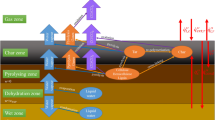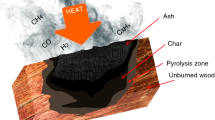Summary
Past research on the combustion and pyrolysis of wood have often indicated a link between wood microstructure and its observed properties in fire exposure. The present research, after utilizing an instrumented fire exposure shown to simulate actual fire conditions, examines the microstructure of fire damaged wood and considers the implications of microstructural changes seen on the burning process.
Differences in microstructural detail between wood and char, as well as fissure geometry, were shown to be consistent. The demarcation between damaged and undamaged wood was shown to be extremely small (several cell layers in thickness). The resulting microstructural observations are considered in light of published kinetic data on wood combustion and current theories and data on thermal degradation of wood.
Similar content being viewed by others
References
Beall, F. C.; Eickner, H. W. 1970: Thermal degradation of wood components; A review of the literature. USDA Forest Service Forest Prob. Lab. Madison, Wisc. FPL Res. Paper No. 130
Beall, F. C. 1977: Properties of wood during carbonization under fire conditions. Wood Technology: Chemical Aspects. ACS Symp. Ser. 43: 107–114
Beaumont, P. W. R. 1974: A fracture mechanics approach to failure in fibrous composites. J. Adhes. 6: 107–137
Broido, A.; Kilzner, F. J. 1963: A critique of the present state of knowledge for the mechanism of cellulose pyrolysis. Fire Res. Abstr. and Rev 5: 2 (157)
Broido, A.; Javier-son, A. C.; Ouano, A. C.; Barrell, E. M., III: 1973. Molecular weight decreases in the early pyrolysis of crystalline and amorphous cellulose. J. Appl. Poly. Sec. 12: 36 (27–35)
Broido, A. 1975: (Pacific Southwest Forest and Range Experiment Station, USDA Forest Service, Berkeley, CA). Personal communication
Broido, A.; Nelson, M. A. 1975: Char yields on pyrolysis of cellulose. Combust. Flame 24: 263–280
Brown, F. L. 1958: Theories of the combustion of wood and its control. USDA Forest Prod. Lab., Madison, Wisc. FPL Res. Paper No. 1236
Cowling, E. B. 1961: Comparative biochemistry of the decay of sweetgum sapwood by white-rot and brown-rot fungi. USDA Forest Service Forest Prod. Lab. Madison, Wisc. Tech. Bull. 1258
Cowling, E. G. 1976: North Carolina State Univ. Personal communication
Exley, R. R.; Butterfield, B. G.; Meylan, M. A. 1974: Preparation of wood specimens for SEM. J. Mecros. 101 (1): 21
Fung, D. P. C.; Stevenson, J. A.; Shields, J. K. 1974: The effect of heat on NH3H2PO4 and the dimensional and anatomical properties of Douglas-fir. Wood Sci. 7: (1) 13–20
Holve, D. J.; Sawyer, R. 1974: Diffusion controlled combustion of polymers. 15th Symp. on Comb. (publisher, The Combustion Institute)
Holve, D. J. 1974: Diffusion controlled combustion of polymers. Univ. of Calif, Berkeley, Fire Res. Group, Report No. 74-4
Kanury, A. M.; Blackshear, P. L. 1966: An X-ray photographic study of the reaction kinetics of α-cellulose decomposition. Pyrodynamics 4: 285–298
Knudson, R. M.; Williamson, R. B. 1971: Influence of temperature and time upon pyrolysis of untreated and fire retardant treated wood. Wood Sci. and Tech. 5: 176–189
Kusy, R. P.; Turner, D. T. 1977: Influence of molecular weight of PMMA on fracture morphology in notched tension. Polymer 18: 391
Lee, C.; Chaiken, R. F.; Singer, J. M. 1976: Charring pyrolysis of wood in fires by laser simulation. 16th Symp. (Int'l.) on Comb. The Comb. Inst. (in press)
Mallick, P. R.; Broutman, L. J. 1975: Mechanical and fracture behavior of glass bead filled epoxy composites. Mater. Sci. Eng. 18: 63–73
McGinnes, E. A.; Kandeel, S. A.; Szopa, P. S. 1971: Some structural changes observed in the transformation of wood into charcoal. Wood and Fiber 3: 77–83
Nolan, P. F.; Brown, D. J.; Rothwell, E. 1972: Gamma-radiographic study of wood combustion. 14th Sympos. (Intern.) on Combustion: 1143–1149
Parker, E. A.; Patzer, W. E.; Ritter, G. J. 1938: The microstructure and diffraction pattern of bass-wood ash. J. Am. Chem. Soc. 60: (72) 2980
Roberts, A. F. 1971: Problems associated with the theoretical analysis of the burning of wood. 13th Symp. on Comb. (publisher, The Combustion Institute) 893–903
Sultan, J. N.; McGarry, F. J. 1967: Toughening mechanisms in polyester resins and composites, Mat. Res. Lab., Dept. Civ. Eng., MIT. Res. Report R 67-66
Tang, W.; Neill, W. R. 1964: Effect of flame retardants on pyrolysis and combustion of α-cellulose. J. Polym. Sci., Part C, 6: 65–81
Tang, E. 1967: Effect of inorganic salts on pyrolysis of wood, α-cellulose and lignin, determined by dynamic thermogravimetry. USDA For. Prod. Lab., Madison, Wisc., Res. Paper FPL 91
Tang, W. K.; Eickner, H. W. 1968: Effect of inorganic salts on pyrolysis of wood, cellulose and lignin by D. T. A. USDA For. Prod. Lab. Madison, Wisc., Res. Paper FPL 82
Uber, F. M.; Goodspeed, T. H. 1936: Microincineration studies III-Shrinkage phenomena during carbonization and ashing of wood. Proc. Nat. Acad. Sci. 22: (8) 463
Vyas, R. J.; Welker, R. 1975: End grain ignition of wood. J. Fire and Flammability 6: (6) 355–361
Wright, R. H.; Hayward, A. M. 1951: Kinetics of the thermal decomposition of wood. Can. J. Tech. 29: 503–510
Zicherman, J. B. Thomas, R. J. 1971: Distribution of Loblolly pine ash residue. Tappi 54 (10): 1727–1730
Zicherman, J. B. 1978: A study of wood morphology and microstructure in relation to its behavior in fire exposure. Ph. D. Dissertation, Univ. Calif., Berkeley. (Available from University micro-films, Ann Arbor, Mich. and as U.C. Berkeley Fire Res. Group Report No. 78-14)
Zicherman, J. B.; Williamson, R. B. 1981: Fire exposure of small wood specimens (In press). Fire Technology
Author information
Authors and Affiliations
Additional information
The authors wish to acknowledge the general support of the University of California Forest Products Laboratory as well as grant support to the University of California Berkeley Fire Research Group (NSF-Rann-S-22053, NFPCA-S-22584), University of California Berkeley Electron Microscopy Lab. (NSF-GB-38359) and the University of California, Davis Department of Botany (NSF-GB-29653). In addition we would also like to thank Dr. Arno P. Schniewind, University of California Forest Products Laboratory and Dr. R. Falk, University of California, Davis, Department of Botany
Rights and permissions
About this article
Cite this article
Zicherman, J.B., Williamson, R.B. Microstructure of wood char. Wood Sci.Technol. 15, 237–249 (1981). https://doi.org/10.1007/BF00350942
Received:
Issue Date:
DOI: https://doi.org/10.1007/BF00350942




